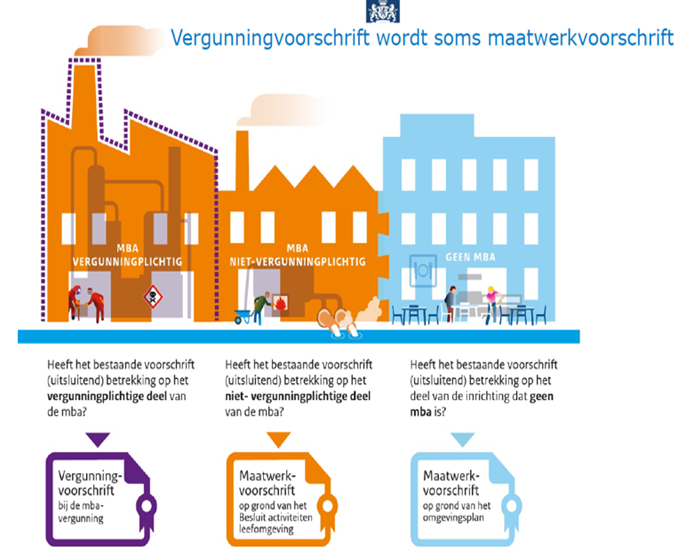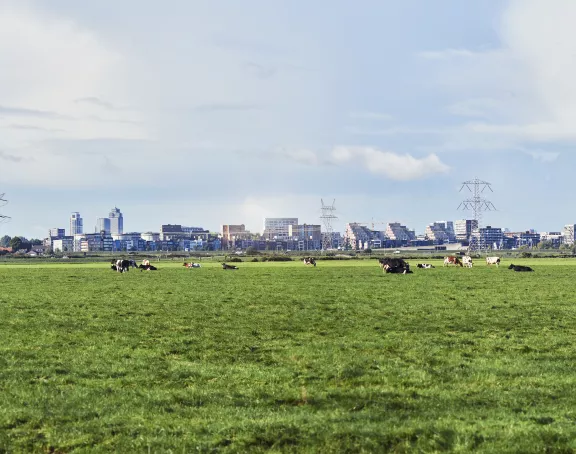Environmental activities – from establishment to environmentally harmful activity (milieubelastende activiteit)
Under the Environment and Planning Act (Omgevingswet), the concept of establishment is no longer the focal point for the regulation (see a previous blog for how that works), but rather the environmentally harmful activity. In this blog post, we describe what happens to permits under the General Environmental Law Act for establishments and what constitutes an environmentally harmful activity within the meaning of the Environment and Planning Act, and we identify some other changes for environmentally harmful activities. Why a different trigger point was chosen has been explained in an earlier blog post.
This post is part of the Environment and Planning Act blog series. In this blog series, we each time highlight a specific topic of the Environment and Planning Act in the run-up to its entry into force on 1 January 2024.
Content
- Will permit requirements under the Environmental Permitting (General Provisions) Act for establishments remain in force under the Environment and Planning Act?
- Does the environmentally harmful activity require a permit or fall under the general rules of the Living Environment (Activities) Decree or the environmental plan?
- Designation as an environmentally harmful activity in Chapter 3 of the Living Environment (activities) Decree is done in three steps
- Can multiple activities be regulated by one permit?
- Other changes
1. Will permit requirements under the Environmental Permitting (General Provisions) Act for establishments remain in force under the Environment and Planning Act?
An irrevocable permit under the Environmental Permitting (General Provisions) Act (Wet algemene bepalingen omgevingsrecht) counts as an Environment and Planning Act permit if that activity is subject to a prohibition within the meaning of Article 5.1.1 of the Environment and Planning Act. Under the Environment and Planning Act, certain environmentally harmful activities are designated as requiring a permit. The permit requirement for environmentally harmful activities is the successor to the environmental permit, which applied to establishments under the Environmental Permitting (General Provisions) Act.
The term 'environmentally harmful activity' is defined as follows in the annex to Article 1.1 of the Environment and Planning Act:
"an activity that may adversely impact the environment, not including a discharge activity into a body of surface water or a discharge activity at a water treatment plant, or any activity involving the extraction of water"
This definition is broad. In my opinion, an activity will soon fall under it. Hobby activities, activities carried out for short periods and 'mobile activities' can also be designated as environmentally harmful activities. Even speaking loudly or baking an apple pie for your colleagues already comes under the Act. Location-specificity remains relevant in the context of environmentally harmful activity designation (see below). Furthermore, environmentally harmful activity designation may also use thresholds, and the scope of the activity is therefore relevant in that context.
The permit requirements under the Environmental Permitting (General Provisions) Act apply as permit requirements under the Environment and Planning Act (Article 4.13(1) and (2) of the Act Implementing the Environment and Planning Act (Invoeringswet Omgevingswet)). Because an activity to which one permit under the Environmental Permitting (General Provisions) Act applies may consist of several (designated) environmentally harmful activities under the Environment and Planning Act, it is relevant with regard to environmental activities to check whether the permit requirements of that permit continue to apply and how they qualify. With regard to transitional law, for an activity for which an irrevocable permit under the Environmental Permitting (General Provisions) Act (Article 2.1(1)(e) applies, a permit requirement under the Environmental Permitting (General Provisions) Act qualifies as:
- a customised rule under the National Rules if the part of the environmentally harmful activity is no longer designated in Chapter 3 of the Living Environment (Activities) Decree (Besluit activiteiten leefomgeving) as requiring a permit but still falls under the rules of the Living Environment (Activities) Decree and may be customised under those rules;
- a customised provision under the environmental plan (omgevingsplan) if part of the environmentally harmful activity is not designated in Chapter 3 of the Living Environment (Activities) Decree and customised provisions may be made under the environmental plan (Article 4.13(3) of the Act Implementing the Environment and Planning Act); and
- an Environment and Planning Act permit requirement if the environmentally harmful activity remains subject to licensing.
Visually, this amounts to the following (visual available at www.IPLO.nl).

To determine which of these three possibilities is at issue, it is relevant to establish whether the activity is designated as an environmentally harmful activity and whether the environmentally harmful activity is subject to licensing or is covered by general rules.
2. Does the environmentally harmful activity require a permit or fall under the general rules of the Living Environment (Activities) Decree or the environmental plan?
Under Article 5.1(2)(b) of the Environment and Planning Act, it is prohibited to carry out "an environmentally harmful activity" without an environmental permit "insofar as it concerns a case designated by an order in council". The designation of environmentally harmful activities takes place in Chapter 3 of the Living Environment (Activities) Decree, in the following Parts:
Part 3.2 cross-industry activities. These are activities that are not specifically tied to a specific industry and can be carried out at different types of businesses. Examples of activities designated as environmentally harmful activities in Part 3.2 of the Living Environment (Activities) Decree are: operating a combustion plant (paragraph 3.2.1), a wet cooling tower (paragraph 3.2.2), a gas storage tank (paragraph 3.2.7) and an independent wastewater treatment plant (paragraph 3.2.15).
Part 3.3 complex companies (Articles 3.50 to 3.92 of the Living Environment (Activities) Decree). What complex companies are is not defined in the Living Environment (Activities) Decree, but is described in the explanatory memorandum. These are business activities with potentially major adverse effects on the physical living environment, such as extensive activities within the chemical industry and the metal industry, for which state regulation is appropriate, also because of the applicable European rules (in particular the Industrial Emissions Directive and the Seveso Directive) (Stb. 2018, 293 , pp. 513-515 and pp. 619-620). Examples of activities designated as environmentally harmful activities in this Part are operating a Seveso establishment (paragraph 3.3.1) or a refinery (paragraph 3.3.3), basic chemicals (paragraph 3.3.8), incineration of waste in an IPPC installation (paragraph 3.3.13) and large-scale manure processing (paragraph 3.3.14).
- Note: for complex businesses, the rules on the designation of general rules and the provision of data and records from Parts 3.4 to 3.11 of the Living Environment (Activities) Decree do not apply. For this reason, from a practical point of view, it is worth starting with Part 3.3 when checking for companies/activities whether there is an environmentally harmful activity that falls under the general rules of the Living Environment (Activities) Decree. we suspect that for a complex company it is easier to determine whether a permit obligation or state rules apply and the environmental plan is relevant than for a non-complex company, as in the latter case a company may consist of several environmentally harmful activities.
- Note: in almost all cases, the designation of complex companies as environmentally harmful activities stipulates that other environmentally harmful activities conducted at the same location and functionally supporting the environmentally harmful activity are also included in the designation. Below, I discuss those criteria.
- Note: for complex companies, one authority is competent, in principle: the Provincial Executives (Article 4.6 of the Environmental and Planning Decree (Omgevingsbesluit)).
Parts 3.4 to 3.11. In these Parts, activities have been designated as environmentally harmful activities from different sectors. Examples include utilities and industry (Part 3.4), waste management (Part 3.5), agriculture (Part 3.6), services, education and healthcare (Part 3.7), sports and recreation (Part 3.9), mining (Part 3.10) and defence (Part 3.11).
- Note: IPPC installations also occur in these Parts.
- Note: a non-complex company that does have sizeable or different activities is likely to fall under several environmentally harmful activities.
3. Designation as an environmentally harmful activity in Chapter 3 of the Living Environment (activities) Decree is done in three steps.
Each paragraph of the aforementioned Parts is structured in almost the same way. In each case, three steps are used to determine what exactly is designated as an environmentally harmful activity, to what extent the environmentally harmful activity is subject to licensing. and which general rules apply.
Step 1: what exactly is designated as an environmentally harmful activity?
In doing so, it is relevant to note:
- what the (core) activity is. The explanatory memorandum mentions making products from metal as an example of a core activity (Stb. 2018, 293 , p. 615-616);
- whether there are functionally supportive other environmentally harmful activities. Many paragraphs identify 'functionally supportive other environmentally harmful activities’ conducted at 'the same location' as part of an environmentally harmful activity; and
- whether exceptions apply. In that case, it usually says "The designation does not cover...".
What constitutes 'functional support' is not defined in the Living Environment (Activities) Decree. According to the explanatory memorandum, functionally supporting environmentally harmful activities serve the core activity and would not exist without the core activity. The explanatory memorandum cites a canteen at a shooting range as an example. Without the shooting range, the canteen would not exist (Stb. 2018, 293, p. 616). A functionally supporting environmentally harmful activity can be either an environmentally harmful activity designated in the Living Environment (Activities) Decree or an environmentally harmful activity not designated in the Living Environment (Activities) Decree.
For 'same location’, according to the explanatory memorandum, the European installation concept from the Industrial Emissions Directive (Stb. 2018, 293, pp. 617 and 613) should be used. We note that there is still little national and European case law on this subject. We can imagine that, in practice, 'immediate proximity' from Article 1.1(4) of the Environmental Protection Act (Wet milieubeheer) is used, as it is a familiar term. However, the question is whether that is the intention. The explanatory memorandum does not explicitly address this. To me, however, 'same location’ seems less broad than immediate proximity.
- Note: according to the explanatory memorandum, the person performing the core activity "always controls the functionally supporting activities" (Stb. 2018, 293, p. 616). It is not immediately clear to me what is meant by this. Currently, control is an interpretation of the organisational bond under Article 1.1(4) of the Environmental Protection Act. Without control, no organisational bond is currently assumed in law.
- Note: the requirement of organisational bonding under Article 1.1(4) of the Environmental Protection Act does not recur under the Environment and Planning Act. This is explicitly stated in the explanatory memorandum of the Living Environment (Activities) Decree (Stb. 2018, 293, p. 627-628).
Step 2: to what extent is the environmentally harmful activity subject to licensing?
This step determines what the permit requirement applies to. Chapter 3 of the Living Environment (Activities) Decree often uses the following sentence: "The prohibition referred to in Article 5.1(2) of the Act to carry out a discharge activity on a surface water body without an environmental permit applies to the environmentally harmful activity referred to in [the designation article]."
- Note: In practice, as far as we can tell, permits under the Environmental Permitting (General Provisions) Act do not always clearly state why exactly a permit requirement applies and to which activities. In addition, transitional law under the Activities (Environmental Management) Decree (Activiteitenbesluit milieubeheer) may cause some of the permit requirements to lapse as of 1 January 2024, for example requirements on emissions to air. This means that for practitioners, it may be a puzzle to determine what exactly is designated as an environmentally harmful activity and why the environmentally harmful activity is subject to permit requirements.
Step 3: which general rules apply? These are also known as the indicators.
This step establishes which general rules apply to the environmentally harmful activity in question. In Chapter 3 of the Living Environment (Activities) Decree, the following sentence is often used: "When carrying out the activity referred to in [the designation article], the rules on..." are complied with.
- Note: any environmentally harmful activity (including functional support activities) is subject to Chapter 2 of the Living Environment (Activities) Decree. This means, for example, that the duty of care always applies as well.
- Note: If there are parts that belong to the establishment now and will not belong to the environmentally harmful activity later, it is possible that these parts:
- independently constitute another environmentally harmful activity subject to authorisation and/or subject to the Living Environment (Activities) Decree. This is the case if the following Parts apply:
- Part 3.2 cross-industry;
- Part 3.3 complex businesses; or
- Part 3.4 -3.11.
- do not independently constitute environmentally harmful activities designated in Chapter 3. In that case, those non-designated environmentally harmful activities will be regulated by local rules, such as the environment plan. Examples in any event include hospitality establishments, gyms, pet boarding houses and restaurants.
- independently constitute another environmentally harmful activity subject to authorisation and/or subject to the Living Environment (Activities) Decree. This is the case if the following Parts apply:
- Note: the environment plan will in any event set standards for noise, odour, vibration, external safety and air. The instruction rules that apply to the municipal council are set out in paragraph 5.1.3 of the Living Environment (Quality) Decree.
4. Can multiple activities be regulated by one permit?
Multiple activities can be regulated under the Environment and Planning Act through a single permit. To this end, the following options exist:
- The activities fall within the definition of environmentally harmful activities. Indeed, certain descriptions of environmentally harmful activities are defined in such a way that several activities can fall under them.
- Example 1: the activities fall within the definition of 'Seveso establishment' (Article 3.50 in conjunction with the Annex to the Living Environment (Activities) Decree). The term ‘Seveso establishment’ is defined in the Annex to the Living Environment (Activities) Decree;
- Example 2: the activities fall within the description of 'operating an IPPC plant for making coke, referred to in category 1.3 of Annex I to the Industrial Emissions Directive' (Article 3.60 of the Living Environment (Activities) Decree).
The Industrial Emissions Directive is relevant to the interpretation of IPPC installation (see also Stb. 2018, 293, pp. 613-614). The definition of IPPC installation in the Living Environment (Activities) Decree refers to the Industrial Emissions Directive. To my knowledge, there is still little European and Dutch case law on this definition. However, there is an older European Guidance that provides some interpretation: Guidance on Interpretation of "Installation" and "Operator" for the Purposes of the IPPC Directive (version April 2017).
- Environmentally harmful activities are part of an environmentally harmful activity because they are carried out at 'the same location' and are 'functionally supportive'.
- It has been explained above what is meant by ‘functionally supportive environmentally harmful activity’.
- Note: the explanatory memorandum states that functionally supportive works one way. The explanatory memorandum cites an example of a combustion plant forming a functionally supportive environmentally harmful activity at a hospital. The hospital does not form a functionally supporting part of the combustion plant, according to the explanatory memorandum (Stb. 2018, 293, pp. 616-617).
- Note: the examples from the explanatory memorandum of the shooting range (with canteen) and the hospital (with combustion plant) make me doubt whether the 'functionally supported environmentally harmful activity' is meant to apply to a situation in which two 'equivalent' companies work together and one of them qualifies as a functionally supporting environmentally harmful activity.
- Article 5.7 of the Environment and Planning Act. Article 5.7 of the Environment and Planning Act states that the applicant chooses whether to apply for the permit for one or more activities.
Note: The Act Implementing the Environment and Planning Act contains a new article on the party subject to regulation, namely Article 5.37a. That article implements Article 4(3) of the Industrial Emissions Directive. Article 5.37a of the Act Implementing the Environment and Planning Act states that the competent authority may stipulate in the environmental permit for cases of activities designated by order in council that there are several permit holders, each of whom is responsible for ensuring compliance with the permit requirements for the part of the activity he performs. The explanatory memorandum cites an example of a company selling part of an IPPC installation to another company.
Note: this is possible only if the different parts of the licensed environmentally harmful activity carried out by different licensees can be sufficiently distinguished from each other (Article 5.37a(1) of the Environment and Planning Act).
5. Other changes
There are also a number of other changes for environmentally harmful activities that operators should be alert to, such as:
- the broadening of options for imposing an administrative fine and requiring financial security;
- the charging fees for permits and bespoke regulations for environmentally harmful activities;
- the possibilities of determining in the permit which part of the permit applies to which natural person or legal entity, and the legal uncertainty and at the same time widening with regard to the successor to the concept of environmental neutral changes;
- the new components of the permit assessment framework, such as a test against the environment plan and out-of-plan environment plan activity; and
- the proliferation of duties of care that operators may face in the context of enforcement. In order to prevent this, they should proactively contact the administrative body for certain cases.
Some of these changes will be discussed later in this Environment and Planning Act blog series.
In conclusion
This post is part of the Environment and Planning Act blog series. An overview of all the blogs in this blog series can be found here.
More information on the background and creation of the Environment and Planning Act can be found on webpage www.my.stibbe.com/mystibbe/pgo. Our webpage includes the consolidated version of the Environment and Planning Act, where all articles of the Act are provided with a relevant explanation based on the legislative history.


